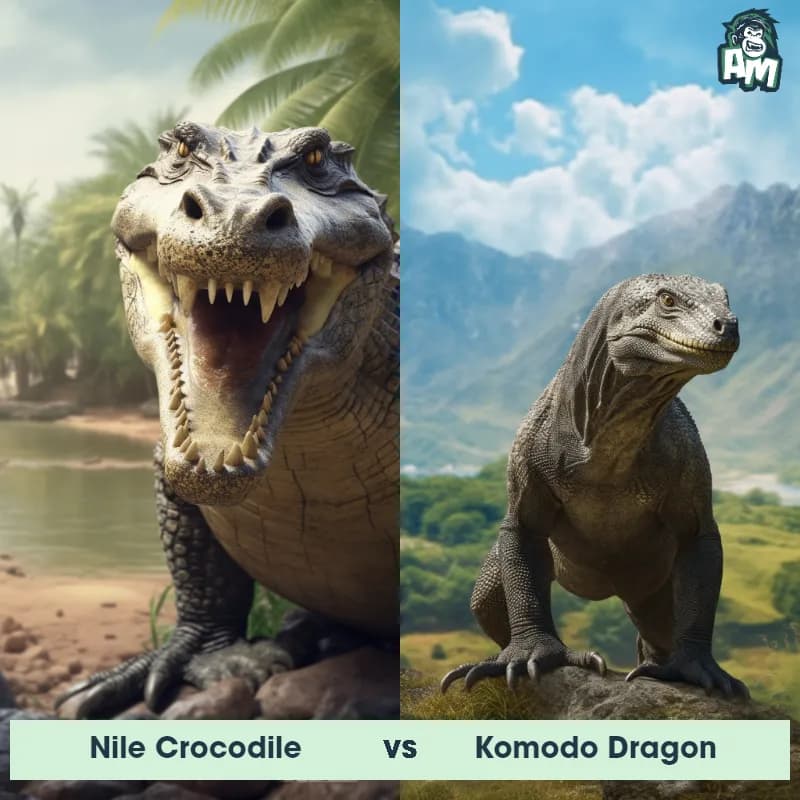Nile Crocodile vs Komodo DragonSee Who Wins

Good evening, ladies and gentlemen! Welcome to this epic clash of titans here at our remarkable venue. We have a thrilling matchup tonight between a formidable Nile Crocodile and a cunning Komodo Dragon. Get ready to witness nature's ferocity in action!
Contender 1: Nile Crocodile
The Nile Crocodile, also known as the common crocodile, is a large reptile that can grow up to 20 feet long and weigh over 1,000 pounds. They have a powerful jaw with sharp teeth and a tough, scaly skin that ranges in color from gray to brown. Nile Crocodiles are found throughout sub-Saharan Africa and are known for their aggressive behavior and ability to take down large prey, including humans.
Fun Fact: Nile Crocodiles are known for their incredible strength and are capable of dragging prey weighing up to 1,000 pounds out of the water and onto land.
Contender 2: Komodo Dragon
The Komodo Dragon, also known as the Komodo monitor, is a large species of lizard that can grow up to 10 feet long and weigh up to 300 pounds. They have rough, scaly skin, sharp claws, and a long, powerful tail. Their teeth are serrated and can deliver a venomous bite that can cause paralysis and death in their prey. They are native to the Indonesian islands of Komodo, Rinca, Flores, Gili Motang, and Padar.
Fun Fact: Komodo Dragons have a keen sense of smell and can detect carrion from up to 5 miles away.
Matchup Stats
| Nile Crocodile | Komodo Dragon | |
|---|---|---|
| Size | Up to 20 feet (6.1 meters) | Up to 10 feet (3 meters) long |
| Weight | Over 1,000 pounds (453.6 kilograms) | Up to 300 pounds (136 kilograms) |
| Speed | Land Speed: 11 mph (18 km/hr) | Speed: 12 mph (19.31 km/hr) |
| Key Strength | Powerful jaw and strong bite force | Powerful jaws and sharp teeth |
| Biggest Weakness | Slow on land and vulnerable to attacks on the underside of its body | Slow movement and lack of agility |
Current Votes
Nile Crocodile vs Komodo Dragon
See Who Wins
View More Matches
Looking For More?
Similar Matches
Scientific Stats
| Nile Crocodile | Komodo Dragon | |
|---|---|---|
| Scientific Name | Crocodylus niloticus | Varanus komodoensis |
| Family | Crocodylidae | Varanidae |
| Habitat | Freshwater rivers, lakes, and marshes | Terrestrial |
| Geography | Sub-Saharan Africa | Indonesian islands of Komodo, Rinca, Flores, Gili Motang, and Padar |
| Diet | Carnivorous, eats fish, birds, mammals, and occasionally humans | Carnivorous, primarily eats deer, pigs, and water buffalo |
| Lifespan | 70 years - 100 years | 20 years - 30 years |
Key Differences between Nile Crocodile and Komodo Dragon
- Body Shape: Nile Crocodile Possesses a streamlined body designed for swift aquatic movement, with a long, powerful tail and a V-shaped snout. Komodo Dragon Exhibits a stocky build with a massive head, sturdy limbs, and a long, muscular tail.
- Geographic Distribution: Nile Crocodile Widely distributed across the African continent, including countries like Egypt, Sudan, Uganda, Kenya, and South Africa. Komodo Dragon Confined to a limited range, specifically the islands of Komodo, Rinca, Flores, and Gili Motang in Indonesia.
- Size: Nile Crocodile Typically larger, with males reaching lengths of up to 16 feet (5 meters) and weighing around 500-1,000 kg (1,100-2,200 lbs). Komodo Dragon Smaller in comparison, with males averaging lengths of 8-10 feet (2.5-3 meters) and weighing around 70-90 kg (150-200 lbs).
- Habitat Preferences: Nile Crocodile Primarily found in freshwater environments such as rivers, lakes, and swamps across sub-Saharan Africa. Komodo Dragon Restricted to the arid, volcanic islands within the Komodo National Park in Indonesia, often residing in tropical forests, scrublands, and savannas.
- Skin Texture and Coloration: Nile Crocodile Features rough, scaly skin with visible osteoderms (bony plates), providing a camouflage of dark green or brown coloration, aiding in aquatic hunting. Komodo Dragon Displays rough, armor-like skin covered in small, prominent scales, which can vary in color from gray to brown, allowing them to blend into their arid island environments.
- Head Shape and Features: Nile Crocodile Shows a broad and angular head with a slightly pointed snout, lined with rows of sharp, conical teeth visible even when mouth is closed. Komodo Dragon Possesses a large, bullet-shaped head with a rounded snout, housing long, serrated teeth that deliver a venomous bite.
































